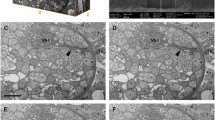Summary
The superposition eye of the sphingid moth, Manduca sexta was explored by means of the scanning electron microscope (SEM). Specifically examined were the corneal nipple array, corneal lens, crystalline cones and tracts, photoreceptor cells and their axons. Descriptions of the external ultrastructure of the components were correlated, where possible with previously published accounts of internal ultrastructure as obtained from TEM studies. A key finding was the demonstration of the axial rotation of the eccentrically situated retinular cell, its externally noted prominence and the arrangement of the other photoreceptor cells composing the retinula. Because of the interest in superposition eye theory, the functional significance of various preretinular optic components was reviewed where it specifically related to Manduca.
Similar content being viewed by others
References
Allen, J. L.: The optical functioning of the superposition eye of a nocturnal moth. Ph. D. Thesis. Massachusetts Institute of Technology. 1968.
Bernhard, C. G., Gemne, G., Sällström, J.: Comparative ultrastructure of corneal surface topography in insects with aspects on phylogenesis and function. Z. vergl. Physiol. 67, 1–25 (1970).
Bernard, G. D., Miller, W. H.: What does antenna engineering have to do with insect eyes? IEEE. Stud. Jan. 8 pp. 1970.
Boëthius, J., Carlson, S. D., Höglund, G., Struwe, G.: Spectral efficiency of single photoreceptor cells of the moth (Manduca sexta). Acta physiol. scand. 74, 36–37A (1969).
Carlson, S. D., Gemne, G., Robbins, W. A.: Ultrastructure of the photoreceptor cells in a vitamin A deficient moth (Manduca sexta). Experientia (Basel) 25, 175–177 (1969).
— Larsen, J. L., Jr.: Scanning electron microscopy of the insect compound eye. I. The apposition eye (Sarcophaga bullata). Z. Zellforsch. 126, 437–445 (1972).
-- Philipson, B.: Microspectrophotometry of the dioptric apparatus and compound rhabdom of the moth (Manduca sexta) eye. Manuscript in preparation.
— Steeves, III, H. R., Vandeberg, J. S.: Vitamin A deficiency: effect on retinal structure of the moth Manduca sexta. Science 158, 268–270 (1967).
Eguchi, E.: The fine structure of the eccentric retinula cell in the insect compound eye (Bombyx mori). J. Ultrastruct. Res. 7, 328–338 (1962).
Fernández-Morán, H.: Fine structure of the light receptors in the compound eyes of insects. Exp. Cell. Res., Suppl. 5, 586–644 (1958).
Fischer, A., Horstmann, G.: Der Feinbau des Auges der Mehlmotte, Ephestia kuehniella Zeller (Lepidoptera, Pyralidae). Z. Zellforsch. 116, 275–304. (1971).
Gemne, G.: Axon membrane crystallites in insect photoreceptors. In: Symmetry and function of biological systems at the macromolecular level. Nobel Symposium II, (eds. Engström, A., Strandberg, B.), p. 305–309. New York: Wiley Interscience Div., 1969.
— Ontogenesis or corneal surface ultrastructure in nocturnal lepidoptera. M. D. Thesis Manuscript, Civiltryck A. B. Stockholm. 69 pp. 1970.
-- Personal communication (1971).
Goldsmith, T. H.: The visual system of insects. In: Physiology of insecta, (ed. Rockstein, M.), vol. I, p. 397–462. New York: Academic Press 1964.
Höglund, G.: Pigment migration and retinular sensitivity. In: The functional organization of the compound eye (ed. Bernhard, C. G.), Wenner Gren Center Internat. Symp. Series vol. 7, p. 77–88. Oxford: Pergamon Press 1966.
— Struwe, G.: Pigment migration and spectral sensitivity in the compound eye of moths. Z. vergl. Physiol. 67, 229–237 (1970).
Miller, W. H.: Personal communication. 1970.
— Bernard, G. D., Allen, J. L.: The optics of insect compound eyes. Science 162, 760–767 (1968).
— Moller, A. R., Bernhard, C. G.: The corneal nipple array. In: The functional organization of the compound eye (ed. Bernhard, C. G.) Wenner Gren Center Internat. Symp. Series, Vol. 7, p. 21–35. Oxford: Pergamon Press. 1966.
Strausfeld, N. J., Blest, A. D.: Golgi studies on insects. Part I. The optic lobes of lepidoptera. Phil. Trans. B. 258, 81–134 (1970).
Varela, F. G.: Fine structure of the visual system of the honeybee (Apis mellifera) II. The lamina. J. Ultrastruct. Res. 31, 178–194 (1970).
Yagi, N., Koyama, N.: The compound eye of lepidoptera. Approach from organic evolution, 319 pp. Tokyo: Shinkyo Press, Ldt. 1963.
Author information
Authors and Affiliations
Additional information
We acknowledge the fine technical assistance of Mrs. Mary Fisher. Research was supported by AFOSR 71-2065 and USPH ITL GM 1076.
Rights and permissions
About this article
Cite this article
Carlson, S.D., Larsen, J.R. Scanning electron microscopy of the insect compound eye. Z.Zellforsch 126, 446–453 (1972). https://doi.org/10.1007/BF00306905
Received:
Issue Date:
DOI: https://doi.org/10.1007/BF00306905




